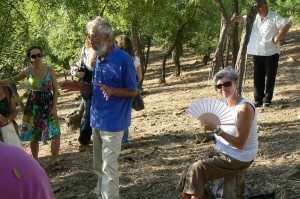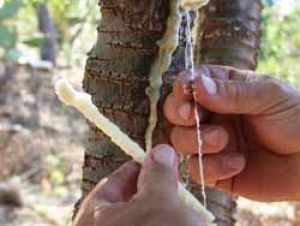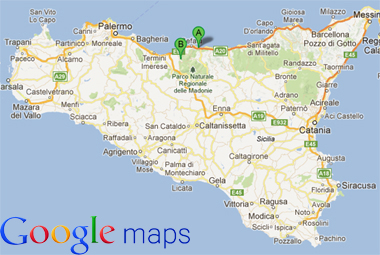Home » The Manna
The Manna
What is manna?
 Manna is a harmless natural substance without any side effects obtained by making incisions with a knife in the trunks of some varieties of ash (Fraxinus ornus and Fraxinus angustifolia). The period of incision and harvesting lasts from the first ten days of July to September when the weather is really hot. As a matter of fact there is a close relationship between the climate during this period and the quantity produced. When the juice, which immediately gushes out of the incision, comes into contact with the air, under the baking hot Sicilian sun, it becomes sweet and solidifies on the trunk. This particular phenomenon is the result of the miraculous coincidence of various favorable environmental factors. Harvesting takes place using special tools and two main qualities are produced: the so called “cannolo” (cream bar) manna – which is the best – and the “broken” or “worked” manna. But the way to produce manna and how to create the best cannolo is due to Mr Giulio Gelardi – Giulio for friends – who discovered a very simple and precise way to produce cannoli
Manna is a harmless natural substance without any side effects obtained by making incisions with a knife in the trunks of some varieties of ash (Fraxinus ornus and Fraxinus angustifolia). The period of incision and harvesting lasts from the first ten days of July to September when the weather is really hot. As a matter of fact there is a close relationship between the climate during this period and the quantity produced. When the juice, which immediately gushes out of the incision, comes into contact with the air, under the baking hot Sicilian sun, it becomes sweet and solidifies on the trunk. This particular phenomenon is the result of the miraculous coincidence of various favorable environmental factors. Harvesting takes place using special tools and two main qualities are produced: the so called “cannolo” (cream bar) manna – which is the best – and the “broken” or “worked” manna. But the way to produce manna and how to create the best cannolo is due to Mr Giulio Gelardi – Giulio for friends – who discovered a very simple and precise way to produce cannoli
Giulio is “the” producer of Manna, a specialty product produced as purely as possible by traditionalists like Giulio himself exclusively in the area around Castelbuono and Pollina (in the Madonie Mountain) and sold to herbalist shops with the support and encouragement of the Slow Food movement (www.slowfood.com), which believes that keeping the tradition alive will preserve the ash groves, the local environment and local culture
A portrait of Giulio Gelardi, THE MANNA MAN, by Giulio himself
 “When I came here thirty years ago, and the manna trade was considered dead, the first thing that came to my mind was to try to produce the manna directly, from the tree extremely clean, in a way to sell it without having to process it industrially. Suddenly, I walked past a tree and noticed that there was a tiny stalactite. I ran back, my mum was sewing, I took a spool, tied the thread around the trunk, together with a drip running down the stalactite. When I returned the following morning, I found a stalactite one meter long. That was the right method. Many take it as a laxative; many others especially in the last years, take it as a depurative. Through the incision I understand the age and the condition of the tree. It’s a way to have a direct relation. At a certain point the tree says: ‘Stop it … I am not going to make any more manna’. It’s not the missing manna that I care about. I just feel like I haven’t understood the tree and what was going on. I feel like I acted as a stranger, not as a friend.”
“When I came here thirty years ago, and the manna trade was considered dead, the first thing that came to my mind was to try to produce the manna directly, from the tree extremely clean, in a way to sell it without having to process it industrially. Suddenly, I walked past a tree and noticed that there was a tiny stalactite. I ran back, my mum was sewing, I took a spool, tied the thread around the trunk, together with a drip running down the stalactite. When I returned the following morning, I found a stalactite one meter long. That was the right method. Many take it as a laxative; many others especially in the last years, take it as a depurative. Through the incision I understand the age and the condition of the tree. It’s a way to have a direct relation. At a certain point the tree says: ‘Stop it … I am not going to make any more manna’. It’s not the missing manna that I care about. I just feel like I haven’t understood the tree and what was going on. I feel like I acted as a stranger, not as a friend.”

Giulio says: “It can be considered as a sweet or a salty product depending on how it is used”. He has been studying manna for thirty years, furthermore he knows by heart the letters by Saint Catherine of Siena who loved Sicilian manna. So, if you tell him about the Torah manna, Gelardi answers you by citing the Nordic myth of the ash tree where Odin died and then was born again getting to the full knowledge. “I have found out some esoteric recipes according to whom manna has some aphrodisiac powers. Do you want to see them?” he continues tirelessly. And “remember that in Greek mythology ash tree nymphs, the meliae, are ancient and warlike”. It is not a joke about them. The tree must be carved, not wounded. When trying to carry him back to nowadays, Gelardi looks at you sympathetically. “Food is culture, otherwise it does not feed and just helps people survive”. That is true, but culture cannot be eaten. Instead it can. In the form of chocolate for example. The Man-chò, produced with Gelardi manna by Quetzal and Don Puglisi cooperatives in Modica, has won the Eurochocolate for innovation. “I have explained to the panel. You award prizes for novelties. But this novelty dates back to several centuries ago. The man-chò is based on the recipe of an abbot who lived in the 17th century.  The manna of Gelardi’s 500 ash trees was awarded in 2008 by foreign press as the product which “best contributes to protect nutritional values of Italian agriculture, food and wine. It is worth at least 150 euro per kilo because it is pure. In Turin during Terra Madre, the international biennial event in its third edition, which has introduced to the five continents’ governments the foundation of the same name, were hundreds of academics from all over the world who listened to the story of a man proud to be a “farmer wearing muddy boots”. “Manna is certainly a miracle” says nowadays Gelardi. “And all the nature as well”. He continues: “First of all it means beauty as between the end of July and the beginning of August you can see ash trees bleeding thousands of white filaments that drip into the fleshy bowl of Indian fig leaves. Can you imagine what enchantment?”. Indeed, this is not all. “The real miracle is the relationship between man and tree.
The manna of Gelardi’s 500 ash trees was awarded in 2008 by foreign press as the product which “best contributes to protect nutritional values of Italian agriculture, food and wine. It is worth at least 150 euro per kilo because it is pure. In Turin during Terra Madre, the international biennial event in its third edition, which has introduced to the five continents’ governments the foundation of the same name, were hundreds of academics from all over the world who listened to the story of a man proud to be a “farmer wearing muddy boots”. “Manna is certainly a miracle” says nowadays Gelardi. “And all the nature as well”. He continues: “First of all it means beauty as between the end of July and the beginning of August you can see ash trees bleeding thousands of white filaments that drip into the fleshy bowl of Indian fig leaves. Can you imagine what enchantment?”. Indeed, this is not all. “The real miracle is the relationship between man and tree.  The ash tree grows everywhere but manna is uniquely produced here, that is in the places where Greeks lived in many centuries before Christ”. The last fifty farmers who know how and when cutting ash tree bark so that the lymph can ooze and condense into manna stalactites, wires and cannoli, all live just round here, between Castelbuono and Pollina whose year of foundation dates back to around 1300, about one hundred kilometers away from Palermo. That’s why all over these hills the Christmas song is like a farm prayer that should help manna flow purely and plentifully. As set in my memory, the prayer is secretly handed down from father to son, from teacher to pupil, always and exclusively the 25th of December but never to “idle ears”. “We did not teach it for decades. We could not sell manna and our young men looked for different jobs”. In fact, in the second half of the twentieth century the pharmaceutical industry had discovered the synthetic manna which was extracted from sugar treacle. So Sicilian ash tree woods were gradually abandoned. Miracles were not over yet. When all hope seemed to be lost, manna succeeded in fascinating new generations so much so that today, among several producers, there are people aged thirty or forty… The old man has come back in the woods to teach the boy and the latter has gone in the woods to be as good and highly esteemed as the former (Cfr I. Cogliani – Itam Comunicazione)
The ash tree grows everywhere but manna is uniquely produced here, that is in the places where Greeks lived in many centuries before Christ”. The last fifty farmers who know how and when cutting ash tree bark so that the lymph can ooze and condense into manna stalactites, wires and cannoli, all live just round here, between Castelbuono and Pollina whose year of foundation dates back to around 1300, about one hundred kilometers away from Palermo. That’s why all over these hills the Christmas song is like a farm prayer that should help manna flow purely and plentifully. As set in my memory, the prayer is secretly handed down from father to son, from teacher to pupil, always and exclusively the 25th of December but never to “idle ears”. “We did not teach it for decades. We could not sell manna and our young men looked for different jobs”. In fact, in the second half of the twentieth century the pharmaceutical industry had discovered the synthetic manna which was extracted from sugar treacle. So Sicilian ash tree woods were gradually abandoned. Miracles were not over yet. When all hope seemed to be lost, manna succeeded in fascinating new generations so much so that today, among several producers, there are people aged thirty or forty… The old man has come back in the woods to teach the boy and the latter has gone in the woods to be as good and highly esteemed as the former (Cfr I. Cogliani – Itam Comunicazione)
___________________________________________________Back To Top























































